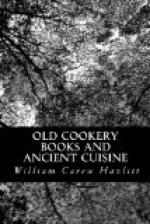The precepts delivered by Lydgate and others for demeanour at table were in advance of the age, and were probably as much honoured in the breach as otherwise. But the common folk did then much as many of them do now, and granted themselves a dispensation both from knife and fork, and soap and water. The country boor still eats his bacon or his herring with his fingers, just as Charles XII. of Sweden buttered his bread with his royal thumb.
A certain cleanliness of person, which, at the outset, was not considerably regarded, became customary, as manners softened and female influence asserted itself; and even Lydgate, in his “Stans Puer ad Mensam (an adaptation from Sulpitius),” enjoins on his page or serving-boy a resort to the lavatory before he proceeds to discharge his functions at the board—
“Pare clean thy nails; thy hands
wash also
Before meat; and when thou dost arise.”
Other precepts follow. He was not to speak with his mouth full. He was to wipe his lips after eating, and his spoon when he had finished, taking care not to leave it in his dish. He was to keep his napkin as clean and neat as possible, and he was not to pick his teeth with his knife. He was not to put too much on his trencher at once. He was not to drop his sauce or soup over his clothes, or to fill his spoon too full, or to bring dirty knives to the table. All these points of conduct are graphic enough; and their trite character is their virtue.
Boiled, and perhaps fried meats were served on silver; but roasts might be brought to table on the spit, which, after a while, was often of silver, and handed round for each person to cut what he pleased; and this was done not only with ordinary meat, but with game, and even with a delicacy like a roast peacock. Of smaller birds, several were broached on one spit. There is a mediaeval story of a husband being asked by his wife to help her to the several parts of a fowl in succession, till nothing was left but the implement on which it had come in, whereupon the man determined she should have that too, and belaboured her soundly with it. At more ceremonious banquets the servants were preceded by music, or their approach from the kitchen to the hall was proclaimed by sound of trumpets. Costly plate was gradually introduced, as well as linen and utensils, for the table; but the plate may be conjectured to have been an outcome from the primitive trencher, a large slice of bread on which meat was laid for the occupants of the high table, and which was cast aside after use.
Bread served at table was not to be bitten or broken off the loaf, but to be cut; and the loaf was sometimes divided before the meal, and skilfully pieced together again, so as to be ready for use.




